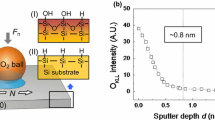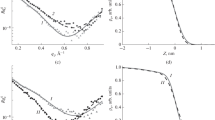Abstract
In this work, the effect of surface roughness and cleaning procedures on reactivity during priming with hexamethyldisilazane is described for four silicon substrates frequently used in semiconductor technology, namely thermally grown SiO2, argon implanted tetraorthosilicate SiO2, polysilicon, and amorphous silicon. Surface energy and roughness were determined by static contact angle measurements and atomic force microscopy. The surface roughness of the silicon substrates increased in the order: thermally grown SiO2, argon implanted tetraorthosilicate SiO2, polysilicon, and amorphous silicon. It was found not to be substantially affected by standard cleaning procedures. The surface energy of all silicon samples decreased with increasing hexamethyldisilazane vapor exposure at 90 °C, and the extent of the decrease corresponded to the surface roughness. Furthermore, a promoting effect on the silylation reaction by an argon implantation process was determined. A correlation between the surface morphology of different silicon materials and reactivity in the silylation reaction with hexamethyldisilazane could be established.
Graphical abstract




Similar content being viewed by others
References
Schneiderman R (2011) IEEE Signal Process Mag 28:8
Franssila S (2004) Introduction to microfabrication. Wiley, Chichester
Li N, Ho C-M (2008) Lab Chip 8:2105
Sackmann E, Tanaka M (2000) Trends Biotechnol 18:58
Rehfeldt F, Tanaka M, Pagnoni L, Jordan R (2002) Langmuir 18:4908
Schultz J, Nardin M (2003) Theories and mechanisms of adhesion. In: Pizzi A, Mittal KL (eds) Handbook of adhesive technology, 2nd edn. Marcel Dekker Inc, New York
Blossey R (2003) Nat Mater 2:301
Khanna VK (2011) J Phys D Appl Phys 44:034004
Petersson L, Meier P, Kornmann X, Hillborg H (2011) J Phys D Appl Phys 44:034011
Lampin M, Warocquier-Clerout R, Legris C, Degrange M, Sigot-Luizard MF (1997) J Biomed Mater Res Part A 36:99
Kern W (2008) Evolution of wafer cleaning science and technology. In: Kern W, Reinhardt KA (eds) Handbook of semiconductor wafer cleaning technology, 2nd edn. William Andrew Inc, Norwich, p 47
Kern W, Puotinen DA (1970) RCA Rev 31:187
Sato M, Kawai A (2006) J Photopolym Sci Tec 19:601
Ponjeé JJ, Mariott VB, Michielsen MCBA, Touwslager FJ, van Velzen PNT, van der Wel H (1990) J Vac Sci Technol B 8:463
Bauer J, Drescher G, Illig M (1996) J Vac Sci Technol B 14:2485
Larsson MP, Ahmad MM (2006) J Micromech Microeng 16:161
Hertl W, Hair ML (1971) J Phys Chem 75:2181
Gun’ko VM, Vedamuthu MS, Henderson GL, Blitz JP (2000) J Colloid Interface Sci 228:157
Hwang K-Y, Park C-S, Kim J-H, Suh K-Y, Cho E-C, Huh N (2010) J Micromech Microeng 20:117001
Helbert JN, Saha NC (1984) Importance of the interface condition upon photoresist image adhesion in microelectronic device fabrication. In: Bowden MJ, Turner SR (eds) Polymers for high technology electronics and photonics. ACS Symposium Series, Washington DC
Hair ML, Hertl W (1973) J Phys Chem 75:1965
Samitsu Y (1993) Nanotechnology 4:236
Busscher HJ, van Pelt AWJ, de Boer P, de Jong HP, Arends J (1984) Colloids Surf 9:319
Vesel A, Junkar I, Cvelbar U, Kovac J, Mozetic M (2008) Surf Interface Anal 40:1444
Chasse M, Ross GG (2002) J Appl Phys 92:5872
Feng B, Weng J, Yang BC, Qu SX, Zhang XD (2003) Biomaterials 24:4663
Ström G, Frederiksson M, Stenius P (1986) J Coll Interface Sci 119:352
Leenaars AFM, Huethorst JAM, van Oekel JJ (1990) Langmuir 6:1701
Widmann D, Mader H, Friedrich H (2000) Technology of integrated circuits. Springer, Heidelberg, p 247
Friedbacher G, Fuchs H (2003) Angew Chem 115:5804
Lee JP, Jang YJ, Sung MM (2003) Adv Funct Mater 13:873
Yang SY, Shin K, Park CE (2005) Adv Funct Mater 15:1806
Cho K, Kim D, Yoon S (2003) Macromolecules 36:7652
Owens DK, Wendt RC (1969) J Appl Polym Sci 13:1741
Rabel W (1971) Farbe Lack 77:997
Kaelble DH (1970) J Adhes 2:66
Lau WS (1999) Infrared characterization for microelectronics. World Scientific, Singapore, p 25
Barr TL, Seal S (1995) J Vac Sci Technol A 13:1239
Acknowledgments
This study was performed at the Institute for Chemistry and Technology of Materials (ICTM) at the Graz University of Technology and at Infineon Technologies Austria AG Villach with funding and contributions from the Polymer Competence Center Leoben GmbH (PCCL, Austria) within the framework of the COMET-program of the Austrian Ministry of Traffic, Innovation and the Ministry of Economy, Family and Youth. PCCL is funded by the Austrian Government and the State Governments of Styria and Upper Austria.
Author information
Authors and Affiliations
Corresponding author
Electronic supplementary material
Below is the link to the electronic supplementary material.
Rights and permissions
About this article
Cite this article
Bodner, T., Behrendt, A., Prax, E. et al. Correlation of surface roughness and surface energy of silicon-based materials with their priming reactivity. Monatsh Chem 143, 717–722 (2012). https://doi.org/10.1007/s00706-012-0730-8
Received:
Accepted:
Published:
Issue Date:
DOI: https://doi.org/10.1007/s00706-012-0730-8




